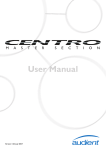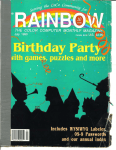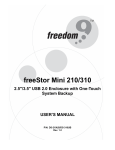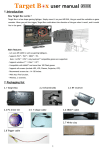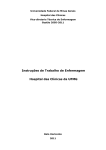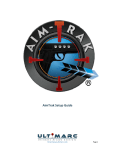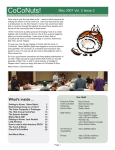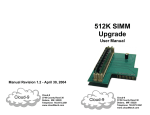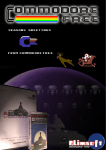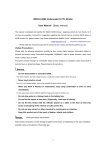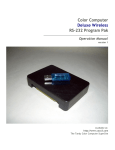Download the PDF of this issue - Retrogaming Times Monthly
Transcript
Retrogaming Times Monthly - Front Cover Click here for the PDF of this issue Printing Help Retrogaming Times Monthly #90 - November 2011 ■ Press Fire To Begin ■ Bewitched Brews - Candy Catcher ■ Retrogaming News ■ Beyond The Plastic: Super Adventure Island - Part I ■ CoCoLicious! - Getting To Know The CoCo ■ Beyond The Plastic: Super Adventure Island - Part II ■ Commodore Du Jour - Mail Order Monsters ■ Dual Perspective - Duck Tales ■ Apple II Incider - Apple II "Turkeys" ■ MAME Reviews - Turkey Shoot ■ Gaming Tetralogies - The Mega Man Series ■ Standalone Spew - The Battle For Football's Second-Best (Part 2) ■ Retro Collecting 101 - Planet Fun In Savannah, GA ■ A Pixelated 21st Century ■ Move 1 Space Forward - Q*Bert The Board Game ■ Game Over file:///C|/Documents%20and%20Settings/ACER%20USER/Desktop/rtm90/frontcover.html[10/31/2011 10:09:07 AM] Retrogaming Times Monthly - Press Fire To Begin With it being November, I figured we all could use a good wholesome Thanksgiving edition of RTM. While most of the columns here are not Thanksgiving themed, that does not mean that this issue is not filling. On the contrary, we actually have two new faces this month that are providing some much needed coverage for RTM. The first new face is Elena García Méndez who will be doing a walkthrough of Super Adventure Island. Then there is Brian Blake who stepped up to the plate to provide some much needed CoCo coverage. Hopefully these new faces provide some interesting reading for you. Feel free to leave them feedback in the comments section of their articles. In other news, I have finally finished indexing all the back issues of Retrogaming Times/Retrogaming Times Monthly. That's right, done. I finally have everything from September 1997-Present indexed and searchable. The only things left to do now is go through the data and make sure everything was categorized correctly and then create an interface so everyone can search easily. It has been a long time coming and there is finally a light at the end of the tunnel. I still don't expect to have it open to the public until January or February as I want to make sure everything is working good, but we are indeed nearing the end. There have been some interesting developments in the classic gaming world. The biggest news comes from the homebrew front where Revival Studios has released AstroDodge for the Odyssey2 and Grant Thienemann has unveiled Candy Catcher for the Atari 2600. Candy Catcher is in the spotlight this month, while AstroDodge should be ready for review in December, so be sure to check back next month for detailed coverage on that one. Enjoy what we have served up for you this month and I hope to see you all next month when our ever popular Christmas issue comes to town! Go to top Leave a comment @Controls Permalink: http://www.retrogamingtimes.com/magazine/?issue=undefined&page=undefined&theme=undefined file:///C|/Documents%20and%20Settings/ACER%20USER/Desktop/rtm90/101.html[10/31/2011 10:09:29 AM] Retrogaming Times Monthly - Retrogaming News Bill Kunkel Dead At 61 Even though this was back in September, I felt that it should get mention here in Retrogaming Times Monthly. It's a shame when someone like Bill Kunkel passes away, the person that helped start Electronic Games Magazine and has been involved with the classic gaming community for some time. He will surely be missed and I wanted to take the opportunity here to give a shout out to Bill and all that he has done. If you want to find out more on his passing and the man himself, click on the link above. New Homebrews October has seen the release of two new homebrew games! Candy Catcher has come out for the Atari 2600 and looks to be quite promising from the screen shots. Also, for you Odyssey2 fans, AstroDodge has been released and again should be a fun one to add to your collection. Look for reviews for both of these new games in the December issue of Retrogaming Times Monthly. Should they turn out to be as fun as they look, you might want to consider getting them as Christmas gifts for that special retrogamer that you know. Retro-Gaming Connexion 2011 Saturday, November 5, 10:00am - Sunday, November 6, 5:00pm (Meaux, France) The Retro-Gaming Connexion organization is proud to announce that its next RGC convention will take place on November 5th and 6th. Like hundreds of enthusiasts during the last seven years, participate in one of the greatest retro/alternative-gaming-themed gatherings in France, and enter the Retro-Gaming Connexion Pantheon! There will be numerous thematic booths where you'll be able to discover rare and exotic consoles, or different ways of playing (e.g. : networked PS1s), New game demonstrations, contests, quizzes, sales/trading, and more. If you live in France or plan on visiting, be sure to check us out. Visit our webpage for more information. Houston Arcade Expo 2011 Friday, November 11, 6:00pm - 2:00am & Saturday, November 12, 10:00am - 2:00am (Houston, TX) This year there will be 200+ Pinball, Arcade & Console games on free play at the Houston Northwest Crowne Plaza. Again this year we are adding additional cash prizes for our tournaments. The Pinball Wizard tournament will start at $100 and increase with a percentage of the entry fees throughout the weekend. We're adding a top qualifier prize of $50 this year along with cash prizes for winning the DMD, 80's and EM pinball tourney's of $25.00. There will also be appearances by the Star Wars 501st legion & the Rebel Alliance! Tickets are $20 for 1 day and $30 for 2 days. Check out our website for more info. If you would like to have your event featured in Retrogaming Times Monthly, just send an e-mail to Bryan Roppolo at [email protected] and he'll make sure to announce it in a future issue. file:///C|/Documents%20and%20Settings/ACER%20USER/Desktop/rtm90/102.html[10/31/2011 10:09:31 AM] Retrogaming Times Monthly - CoCoLicious! Getting To Know The CoCo Greetings Retro-Computing fans! My name is Brian, and I’m told that I'm a confirmed CoCoNut. CoCoNutz are a small, but loyal group of people trying to enjoy what we feel was one of the best 8-bit computers released during the 1980’s – the TRS-80/Tandy Color Computer. What’s that sound? Oh, that must be the collective sighs from some Apple and Commodore fans. Relax, I’m not here to try and restart the 8-bit wars; rather, just try to provide some useful info to folks who may be interested in learning about a very under-rated 8-bit machine. I'm a big fan of retro-computing in general. In my not so humble opinion, the computers of today, while far more powerful, are equally less personal. The 8-bit machines of old are far easier to learn to work on and repair down to the component level. Manufacturers provided schematics and service manuals for people to use to diagnose their own machines to repair them. Not so much for today's machines. While I'm partial to the CoCo, I also have a smallish collection of other classic computers. Here's a list of what I have: 5 - 512k CoCo3' (3 have 6309's) 1 - My ongoing repack CoCo3 which is 512k, upgraded to a 6309, 23.5" floppies, A Roy Justus VGA adapter connected to a 15" HP LCD, MPI, and a Radio Shack multimedia sound system is being installed. All jammed into a Model III case using a Model III keyboard. 2 - CoCo2's (one is a 3127B lowercase capable) 1 - grey CoCo1 w/CoCo2 k/b 1 - grey CoCo1 w/aftermarket k/b 1 - White CoCo1 5 - MPI's (3 upgraded for use with CoCo3's) 3 - FD-501 ( 1 with 2 3.5" DS/DD drives, 1 with 2 DS/DD 5.25's, and 1 with 1 5.25 and 1 3.5) 1 - FD-502 with a single DS/DD drive 1 - TRS-80 Model IV 1 - CoCo mouse 1 - Tandy RS-232 pak 1 - Speech Systems 'The Voice' 2 - R/S Speech/Sound Paks 1 - WICO j/s adapter for the CoCo 1 - 26-3022 FD Controller 1 - FD-500 FD Controller 3 - FD-501 FD Controller 1 - Tandy 1000HX Below is my CoCo setup I use regularly: 512k CoCo3 w/63C09EP MPI modified for use with a CoCo3 with the following in the slots: 1. FD-501 FDD controller, 3.5" floppy 2. Cloud9 Super IDE with 2GB CF card and a 6.4GB Maxtor HDD 3. Roger Taylor MicroSD DrivePak (the last slot is swapped with the following depending on what I'm working on) file:///C|/Documents%20and%20Settings/ACER%20USER/Desktop/rtm90/201.html[10/31/2011 10:16:21 AM] Retrogaming Times Monthly - CoCoLicious! 4. Roger Taylor Serial Pak used for wireless serial CoCo <-> PC communication with XBee modems 5. Roger Taylor Serial Pak used for wireless serial CoCo <-> PC communication with a Bluetooth module 6. Video thru a Roy Justus VGA adapter to a 24" Asus LCD Me and my CoCo… To start with, though, I’ll provide a little information about my experience with the CoCo. Right before my 13th birthday, my parents decided to get me a computer. We looked all over and at many different models. I was partial to the Atari 800; I just thought it looked cool. Mom and Dad were not convinced yet, and decided to talk to a couple of my cousins who had already purchased a TRS-80 Color Computer, and were using it in their businesses. When we got to my cousin’s place, all I saw was this grey wedge sitting on his desk, with a grey hunk of metal and black plastic, I later found out was a disk drive. To say I wasn’t impressed would be an understatement. It had NONE of the sleek lines I saw in the Atari 800, or even an Apple II, and don’t even get me started on the keyboard. Who thought up that design anyway? While my parents were getting an education, I sat in a corner being grumpy; I wanted to play cool games like Donkey Kong, Frogger and Zaxxon (well, Zaxxon hadn’t been released yet, but, you get my point). Later on, we were discussing the computer while eating dinner at Friendly’s, I got the brilliant idea to tell mom and dad that I wanted the Atari 800; or nothing. Mom and dad said, “Fine.” That’s the point in my life when I learned about discretion… Based on the above, you can understand why I was surprised when some packages arrived from Computers Plus the day after my birthday. Much to my surprise, mom and dad had gone ahead and purchased a TRS-80 Color Computer, disk drive, and an Okidata Microline 82A dot matrix printer. While I wouldn’t exactly call it a religious experience, it was still pretty darn cool! Looking back now, I can say that I completely ‘geeked out’ for lack of a better phrase. Things didn’t work out too well at first; the computer didn’t work. The order was placed for a 64k CoCo, what we got was a CoCo with an incomplete memory upgrade… Shortly after getting the CoCo back from having the upgrade completed, I began to see the capabilities it had, and the disk drive was awesome – far better than the tape recorders most of my friends were rockin’ at the time, and much faster than the disk drives my friend's Atari computers had. Also, since two of my cousins had a CoCo, I also had access to a software library. Shortly after I got Telewriter-64, one of the premiere word processors for the CoCo, I found out I could make money by writing resumes. Not to mention how much nicer my school reports were printed out instead of typed, especially for error correction. Then I found out about DAYCCUG – the Dayton Area Color Computer Users Group – I had found geek heaven. Meeting twice a month, here was a group of people willing to help, teach, repair and upgrade all things CoCo related. One member had even taken a CoCo and repacked it into a TRS-80 Model III case - which was the epitome of 'cool' for me. Which brings me to this – exactly which TRS-80 am I talking about? I’ll give you a hint; It’s not the band… Who is 'TRS' and what’s an '80'?? Even here in the new millennium, I still know people, computer literate people, who do not know what TRS-80 stands for, nor do they know what the differences are between the different models. So, I’ll attempt to explain at a basic level about the differences in the TRS-80 computers. When Tandy released the TRS-80 Model I in 1977, it was sold in select Radio Shack stores, and was an instant success - sold tens of thousands in the first year. But what does TRS80 stand for? Many people did not know that Radio Shack had a parent company, and that company was Tandy (yes the leather people), owned by Charles Tandy. So it turns out that, TRS stands for ‘Tandy/Radio Shack.’ Since the CPU used in the Model I was the Zilog Z-80, they took the 80 from that to complete the Radio Shack computer moniker known as TRS-80. In 1979, the Model II was released, while 1980 saw the release of the Model III, file:///C|/Documents%20and%20Settings/ACER%20USER/Desktop/rtm90/201.html[10/31/2011 10:16:21 AM] Retrogaming Times Monthly - CoCoLicious! both using the Z-80, kept the TRS-80 brand name, which also carried to the Model IV later. Those are really the main computer sold under the TRS-80 moniker. There was also a Model 12 and Model 16 (later the Tandy 6000), which were business machines that could run CP/M. In keeping with the ‘80’ naming scheme, these machines were Z-80 powered. Later in their model runs, late 1985ish, Tandy rebadged the TRS-80 line to Tandy. This is where the story takes a slightly unexpected turn, as Radio Shack wanted to add another computer to their lineup. In the late ‘70’s, they teamed with Motorola to develop a product for the agricultural industry, which became the Videotex terminal. The design was based off the Motorola 6809 CPU, the 6847 VDG (video display generator) and the 6883 SAM (synchronous address multiplexer). In July of 1980, the same basic machine was released as the TRS-80 Color Computer, sporting 4k DRAM, and for this computer, Tandy wisely licensed Microsoft BASIC. The big difference being, the CoCo had joystick and serial ports on the back and a hardware interface port on the right side. Upon its release, the only mass storage device available for the venerable computer was a cassette recorder. That was solved a year later when affordable disk drives became available. Numerous memory upgrades were also offered, from 16k to 64k. There were kits which offered 256k, which was addressable using various bank switching techniques or offering the use of RAM drives. Some of the most purchased upgrades, however, were the keyboards. The chiclet keyboard found little love among people who considered the CoCo a toy computer because of the keyboard. The CoCo lacks certain features other computers of the time had; hardware sound – the CoCo has a 1-bit DAC; hardware sprites – missing on the CoCo; a real, full travel keyboard – not found on the CoCo. You may be getting the idea that I dislike the chiclet keyboard, and you’d be correct. However, what the CoCo had that no other 8-bit computer of the time did, was the MC6809 CPU – considered by many to be the most advanced 8-bit CPU ever made. Many would ask, “What’s so great about the 6809?” Which is a great question, really. For one, it has two 8-bit accumulators, which can be combined into one 16-bit register. Second, there are two 16-bit index registers and two 16-bit stack pointers. Essentially, this means it’s an 8-bit CPU, with a 16-bit data path, which had the effect of making the CPU several times faster than equally clocked CPU’s, to the point where it could compete with even a Z-80 which were usually clocked up to 5 times higher. However, if you took a survey of people who coded on multiple 8-bit systems, many would say that programming the CoCo was a much better experience. In fact, and 1987 issue of Computer Shopper had the following to say; “When programming in machine language, moving from the PC to a TRS-80 Color Computer is like getting out of a Pinto and climbing into a Ferarri.” While I’m not an Assembly coder, I’ve heard enough people who say similar things, so I almost have to take it at face value. When planned and properly executed, there's few things a good coder cannot do with a CoCo. Heck, if he'd had a CoCo, David Lightman may have succeeded at starting WWIII! There have been a large number of games for the CoCo that many people do not know about. Tom Mix Software was one of the numerous publishers of high quality video games. One such game was Donkey King; a clone of Donkey Kong which was so close to the arcade version, it’s rumored it had to be renamed to ‘The King’ to avoid being sued by file:///C|/Documents%20and%20Settings/ACER%20USER/Desktop/rtm90/201.html[10/31/2011 10:16:21 AM] Retrogaming Times Monthly - CoCoLicious! Nintendo. I’m actually looking at doing a review of Donkey King/The King for an article shortly. They are also responsible for Sailor Man (a Popeye clone) and Buzzard Bait (a Joust clone) and quite a few other quality games. I’m also hoping to try to get interviews up of some of the authors. The things that really held the CoCo back were the lack of some supporting hardware features (sound and sprite capability), and Radio Shack itself. During its 12 year run, Tandy and Radio Shack did more to thwart the CoCo than support it. It was the proverbial 'red headed step-child' to the other computer lines Tandy sold, and it was treated as such. I'll go into the details of this in a future article, but, without support from magazines like The Rainbow, Hot CoCo and Color Computer Magazine, the CoCo would not have had the popularity it did. That’s about it for this month. Hopefully I haven’t bored anybody with this discussion of the TRS-80 computers. Indeed, if I’m lucky, maybe someone out there may have picked up something useful from this article. Next month, I’ll go into a little more detail about the CoCo’s hardware, the differences between the three models of the CoCo, and put up some screen shots of CoCo games of the early-mid ‘80s. Future plans include reviews of classic CoCo games, some of the new hardware that's available, as well as some games that have come out in recent times. Feel free to contact me with any questions, comments or suggestions. Like Be the first of your friends to like this. Go to top Leave a comment @Controls Permalink: http://www.retrogamingtimes.com/magazine/?issue=undefined&page=undefined&theme=undefined file:///C|/Documents%20and%20Settings/ACER%20USER/Desktop/rtm90/201.html[10/31/2011 10:16:21 AM] Retrogaming Times Monthly - Apple II Incider Apple II "Turkeys" Happy November everyone! Welcome to the November edition of Apple II Incider. Bryan asked if we could do a Thanksgiving themed column this month. I poked around for some games that might fit the theme but had no luck. I read about a game called Turkey Shoot for the Apple IIGS but did not find it anywhere (although the arcade version is being reviewed this month over in MAME Reviews). I revisited some of the past columns to see what I wrote about. Surprisingly, the past three years, I have not written anything specifically for Thanksgiving. However, a great idea popped into my mind. Rather than look for a Thanksgiving themed game, how about writing about some Apple II games that were "TURKEYS" or also known as "some of the worst games I have ever played"? On the surface, this might seem like a difficult task. However, I distinctly remembered a couple games I got in the ‘80s that were about the worst I'd ever seen. In fact, in searching for some screen shots or maybe even disk images of these two games, I stumbled across a posting I put on the comp.sys.apple2 Usenet group back in 2006: Hi all, Hope all is well! We all usually tend to ask "what was the Best Software/Hardware/etc ever for the Apple II...", I'd like to take a different approach. Namely, what were the worst games you ever played on your Apple II? We all have great memories of our Apple II computers but I'm sure we all remember some duds that had us saying "what the heck were they thinking?" My votes go to a couple of games I bought from a bargain bin at Kay-Bee toys back in the late 80's/early 90's: Nitro Alert (some alien space shooter) Highway Trap (some ground based car shooter) Both games were produced by a company I have never heard of: ALA Software. While the descriptions on the box sounded promising, but games were major disappointments. I was expecting some high action and good graphics. Instead, I got games that seemed there designed for the public domain. Graphics were poor and the games were limited to a single screen with no vertical or horizontal scrolling. I guess I should have known better than to expect much from the Bargain Bin. :) I did some searches online and it does appear ALA made software for the Atari 8 bit machines, perhaps they thought they could make some quick bucks with the Apple II. Worst of all, I picked up a couple of "application" software from ALA as well (at the same bin). My dad never did find much use for it. :D Don Reading this old posting (and some of the replies) was certainly entertaining and brought back some old memories of both the games and shopping for bargain stuff at KayBee Toys. Given the dismal quality of these games, it's probably no surprise that I couldn't find any game screen shots nor did I see them online or in one of the major Apple II software archives. I believe I still have the disks somewhere though. It would be interesting to convert them to disk images and upload them for future generations to "enjoy". In all seriousness, these two games were pretty bad and not worth taking a look at unless you are a sucker for punishment. To finish, here's a description from the game box. Check it out and you'll see the game description is not bad though it's telling that there were no screen shots on the box itself! Happy Thanksgiving everyone! file:///C|/Documents%20and%20Settings/ACER%20USER/Desktop/rtm90/202.html[10/31/2011 10:31:19 AM] Retrogaming Times Monthly - Gaming Tetralogies The Mega Man Series Gaming Tetralogies covers four of the best games from any single game series on any platform. The games will not be listed in any particular preference order but by release date and will be more of a must have list for each series. Feel free to comment on any games in the series you feel should have been included. Mega Man 2 (1989) - Nintendo Entertainment System The second iteration of the original Mega Man series is the best polished with an increasing difficulty and some strategy thrown in near the end. This was before gimmicks such as the Mega Buster, Rush the Dog (although there were item numbers that were kind of similar), and even the slide were implemented. The music in Part 2 is some of the best, not only in a Mega Man game, but on the NES as a whole. Mega Man V (1994) - Nintendo Game Boy Almost all of the Game Boy Mega Man games were a rehash of the console versions bringing in a couple of bosses from 2 sequential games. However, Mega Man V was something of an entirely different beast. The bosses were named after planets and their levels were all themed accordingly. The gameplay was challenging yet not impossible and the ending was very memorable. By far the best portable 8-bit Mega Man title. Mega Man X (1994) - Super Nintendo When Nintendo moved into 16-bit territory, so did the blue bomber. In classic SNES fashion, Mega Man, now called simply X, can not only do all of his gimmicks from the 8-bit era but he can also now be upgraded as you find capsules in various levels. The bosses are no longer simply modeled after an element but also have an animal twist and the new main antagonist is the rebellious Sigma. One of my favorite bosses has to be Storm Eagle with an awesome theme and a unique boss fight stage. file:///C|/Documents%20and%20Settings/ACER%20USER/Desktop/rtm90/203.html[10/31/2011 10:33:10 AM] Retrogaming Times Monthly - Gaming Tetralogies Mega Man ZX (2006) - Nintendo DS Out of all the different reboots of the Mega Man series such as the Zero series, Battle Network, Legends, and Star Force, ZX stands out to me as the closest to the original formula without changing too much of what made the original series great. ZX essentially comes after Zero, which comes after X, which comes after the original, so it's essentially the next iteration and has a lot of history. The gameplay is a little less linear than the other games in the main canonical series, but not as drastically Metroidvaniaish as what the sequel moves towards. Overall it is a favorite of mine and one of the best in the Mega Man series. Like Be the first of your friends to like this. Go to top Leave a comment @Controls Permalink: http://www.retrogamingtimes.com/magazine/?issue=undefined&page=undefined&theme=undefined file:///C|/Documents%20and%20Settings/ACER%20USER/Desktop/rtm90/203.html[10/31/2011 10:33:10 AM] Retrogaming Times Monthly - Retro Collecting 101 Planet Fun In Savannah, GA Stopping in Savannah, GA on my way to South Carolina I expected the area to be very uneventful as nothing showed up on Google Maps, on my phone's GPS, or even in the Yellow Pages in the hotel room. Using my last ditch effort, I checked around on Craigslist and found a place called Planet Fun in downtown Savannah. Savannah is a pretty rural place, however, downtown is a vast area where you need to park and walk a mile or two to get where you need to go. After confirming that the place was open, I headed out and what I found was completely unexpected. According to the owner, he had just opened the store a week or so prior and basically thought it would be cooler to have an awesome retro gaming store, instead of an awesome retro gaming collection. Looking around there were tons of gems such as Earthbound and Final Fantasy VII, however even the games not in the display cases were above the normal par of games, and most of them were in amazing condition. This store is a true testament of someone who really loves video games and it shows. Lucky for me, I wandered into the shop right after someone brought in their vast Nintendo collection which consisted of over half of the NES library. I keep a list of not only every game that I own, but also every game that I want to get with only a few dozen left in my "to get" list. It was amazing that I was able to find 18 games that were on my list! Never did I expect in my rest stop to find a place that would have so many uncommon video games. My hats off to Planet Fun and if you are ever in the Savannah area, stop by and get some games! You can check out their Facebook page at http://www.facebook.com/pages/Planet-Fun-Savannah/192550347462387 Like Be the first of your friends to like this. file:///C|/Documents%20and%20Settings/ACER%20USER/Desktop/rtm90/204.html[10/31/2011 10:09:38 AM] Retrogaming Times Monthly - Move 1 Space Forward Q*Bert The Board Game From the box: Q*bert A Board Game Based on the Exciting Arcade Game [Ages] 7 to 14 [Number of players] 2 [Equipment] Game board 7 character playing pieces (Q*bert, Coily, Slick, Red Ball, Green Ball, Ugg, Wrong Way) 3 flying discs 1 six-sided die 1 eight-sided die 1 character die Q*bert secret die-rolling tube 28 pegs [Approximate playing time] 15 to 30 minutes [Object] Be one the of the “noser elite” by collecting more pegs than your opponent. First you’re Q*bert, moving around the pyramid trying to get as many pegs as you can. But watch out! Your opponent controls the “nasty” characters that want to stop you. Will they succeed, or will you escape from them? Collect all the pegs you can, then let your opponent take a turn as Q*bert. Now you control the “nasty” characters – can you stop your opponent from getting more pegs than you? The Q*bert who collects more pegs is the winner. Rules of the game: Click to view the Instructions (in PDF format) Review: After unpacking the game it is easy to identify all the major elements from the 1982 arcade game hit. The unmistakable isometric platform of colored cubes is here as large and as bright as ever. The pyramid was not modified to fit the board game and contains all 28 cubes with yellow, red and blue sides. In the arcade game each cube would change colors as Q*bert landed upon it. The board game version represents the change by removing small white pegs that fit into holes on the top of each cube. The pegs are removed as Q*bert lands on each cube. The infamous colored Flying Discs that wisk Q*bert to safety are also included and are represented by colorful stickers applied to a black disc shaped piece with a peg in the bottom. Q*bert is here in all his glory although he appears in the form of a sticker applied to a very generic traditional yellow file:///C|/Documents%20and%20Settings/ACER%20USER/Desktop/rtm90/205.html[10/31/2011 10:35:39 AM] Retrogaming Times Monthly - Move 1 Space Forward playing piece. All of the “nasty” characters (Coily, Slick, Red Ball, Green Ball, Wrong Way and Ugg) that chase and harass Q*bert are also present and represented by stickers on the same generic yellow playing pieces with the exception of Wrong Way and Ugg. The latter use the same black disc shaped piece as the Flying Discs. Game play follows very close to the arcade game allowing for alternate play. Players take turns playing as Q*bert while the other plays as the “Nasty” characters. There are 3 dice: one six sided, one eight sided and one character die. The eight sided die is used in conjunction with a secret die-rolling tube to move Q*bert. Q*bert does not have to move all of the spaces indicated by the roll and can instead save any remaining moves as escaping moves. Q*bert collects the pegs from the cubes he lands on. The character die and six sided die are used by the other player to move the indicated “nasty” character. There are too many movement related rules to explain here, so I will leave that to the instructions, but suffice to say that once you have them down you will find it follows the arcade game almost perfectly. Once Q*bert has been captured by one of the “nasty” characters the board resets and the players switch roles. The game ends after both players have had their turn as Q*bert. The player who has collected the most pegs during their turn as Q*bert wins. I think this may be the best arcade game to board game conversion I have ever played. With the exception of the playing pieces, Parker Brothers really outdid themselves in truly reproducing all of the elements of the arcade. Now it must be said that in doing so they also made for a very large learning curve. It will take quite a few games before one is completely comfortable with all the movement rules, but in the end you are rewarded with a very accurate arcade game experience. This is as true to the arcade as it can be and should provide great replay value with any Q*bert fan! Remember: When Pac-Man's away, the ghosts will play! Wocka! Wocka! Like Be the first of your friends to like this. Go to top Leave a comment @Controls Permalink: http://www.retrogamingtimes.com/magazine/?issue=undefined&page=undefined&theme=undefined file:///C|/Documents%20and%20Settings/ACER%20USER/Desktop/rtm90/205.html[10/31/2011 10:35:39 AM] Retrogaming Times Monthly - Bewitched Brews Candy Catcher Candy Catcher is a Halloween themed homebrew game for the Atari 2600 and released as a cartridge (priced at $20) or a free downloadable file in October 2011 by Grant Thienemann. Grant programmed the game in Batari Basic in 13 days. The original release was promoted in a post on AtariAge on October 9, 2011 as a loose cartridge with an original Atari style text label. Grant decided to sell the game numbered, but not limited. Soon after, a different version packaging of the game was to be produced to include a box with matching non-traditional label style (for $35). The cartridge is of excellent quality, produced by experienced homebrewer and AtariAge owner Albert Yarusso, and comes complete with an authentic text label design. Candy Catcher captures the arcade style of classic Atari VCS games and is a solid homebrew with responsive controls. The graphics are basic, although certainly recognizable. Your character is large and bold. The game is good fun. Candy Catcher is a dropping object game which owes a debt to Kaboom. Thankfully, it feels different than a simple hack of that classic title. Your character carries a Halloween basket along the bottom of the screen for catching the dropping candy. If you miss any sweets or touch them with your body, you lose points. You only get points by catching them precisely in your basket. At the same time as you are trying to catch all this candy, your character is being antagonized by a robot Berzerk derivative character that appears a little while after you start the game. He only has a simple back and forth pattern at the bottom of the screen luckily, so nothing too complicated. He seems like a simplified version of the spider from Centipede. Fortunately, jumping is well designed. Your character can land on the robot and kill him for points. Unfortunately he returns momentarily with a vengeance and increased speed every time you kill him. The result is a game that ramps up satisfyingly and stays short, like a classic arcade game should. The scoreboard has space for six figures, but I had trouble breaking 300 routinely. There are two difficulty levels, and although I couldn't tell the difference between them, I did score a little higher on the easy setting. Creating games for classic systems is a labor of love, and this is a fine first release from Grant Thienemann. It would have been nice to have more game variations, a background graphic for the action, a title screen, 2-player options, or paddle support. None of these shortcomings detract significantly from this reasonably well designed game. If you like to add interesting well packaged homebrew games to your collection, Candy Catchers is a challenging arcade release that you will enjoy owning. I’d rate this one a 5.5 / 7 (78%), or on the Ms. Pac-Man Rating Scale, somewhere between a Store bought Apple and a Tree picked Pear. file:///C|/Documents%20and%20Settings/ACER%20USER/Desktop/rtm90/301.html[10/31/2011 10:10:03 AM] Retrogaming Times Monthly - Bewitched Brews Like Be the first of your friends to like this. Go to top Leave a comment @Controls Permalink: http://www.retrogamingtimes.com/magazine/?issue=undefined&page=undefined&theme=undefined file:///C|/Documents%20and%20Settings/ACER%20USER/Desktop/rtm90/301.html[10/31/2011 10:10:03 AM] Retrogaming Times Monthly - Beyond The Plastic Super Adventure Island - Part I The creator and developer of the Adventure Island games is the Hudson Soft Company, a subsidiary of the Konami Corporation, based in Tokyo and Sapporo, Japan. Established in 1973, Hudson focused on PC products before entering the exciting world of video game creation, development, and publishing. Hudson founders Hiroshi and Yuji Kudo could maybe be described as Japanese train-spotters, having named their company after Hudson locomotives! Initially in the business of selling photographs and telecommunications gadgets, by 1978 Hudson had expanded into computer games. Hudson began creating games for Nintendo, including the famous Lode Runner, Bomberman, and others. The company continued the development of several games on numerous platforms. Hudson’s success continued into the 1990s, with the creation and publication of video games for many different systems. From 1988 to 1995, the USA division of Hudson was based in South San Francisco. From here, the company published games for the Game Boy and both Nintendo and Super Nintendo systems. Hudson created Hudson Entertainment, based in San Mateo, California, in 2003. It was in operation until its dissolution in 2011, having since created its Java game service for cell phones. In 2001 Konami became the major Hudson shareholder, and later Hudson’s parent company. Though Hudson continued its independent publishing, it worked directly with Konami. In 2011, Hudson was bought outright by Konami. Other Hudson-created games, some for other publishers, include Bonk, Fuzion Frenzy 2, and the Mario Party series. Super Adventure Island overview I can’t wait to review this fun game. Let’s get to it! The story starts with Master Higgins (who represents you, the player) and his girlfriend Tina spending some time together in a treetop, gazing at the stars. Suddenly a dark-cloaked villain—the dark lord— appears riding his broomstick. While hovering nearby, the dark lord casts a spell that turns Tina into stone! Master Higgins then hitches a ride on an eagle, which drops him with a bang on the beach. Rescue operations to save Tina commence. This is where the adventure begins!! Controls: There are three types of jumping you must learn on Super Adventure Island: The standard jump The high jump while moving The super jump file:///C|/Documents%20and%20Settings/ACER%20USER/Desktop/rtm90/302.html[10/31/2011 10:10:03 AM] Retrogaming Times Monthly - Beyond The Plastic The super jump you achieve by ducking and pressing the jumping button. It’s vital to get familiarized with and master these jumps in order to beat the game. Your weapons, the axe and boomerang, are your most useful tools in completing this game successfully. The difficulty however is that it is very hard to aim well at the enemies in order to destroy them. Above all, remember that if you get hit once, you will have to start the whole stage again! In some stages a skateboard will appear. By all means, jump on! It lets Higgins move around obstacles much faster than by running. Super Adventure Island is made up of five rounds of four stages each. In each fourth stage, you will meet a boss you must defeat. In the fourth stage of round five, you must do battle with the ultimate boss. Round 1 Our main character has to run, run like mad through each stage. The basic tools to help you get through the stages are the axe and the boomerang. Initially, there are no other options offered in this game. However, if you continue to collect either more boomerangs or axes, these weapons can change into powerful fireballs which are even more potent weapons to use against your enemies! You have to be particularly careful about your health bar. This is shown across the top of the screen, made up of 16 units (count them if you don’t believe me!). The numbers of units represent Higgins’ health level. As he goes jumping and running Higgins’ energy depletes and he needs nourishment to replenish his health units. If all 16 of your health units are depleted, you will lose one life. Nourishment is offered in the form of fruits which appear in Higgins’ path as he goes through the game. You must grab every fruit you can as you run and jump along. Each fruit you consume adds one health unit to your health bar. There are three fruits available: banana, kiwi and pineapple. Yummy! The main enemies you will find at this stage are seashells, rocks, and some blue dinosaurs which fly with the aid of balloons! You must eliminate the shells and dinosaurs with your weapons, and avoid tripping over the rocks. Each time you trip on a rock, your health bar is reduced considerably. You will also get familiarized with the skateboard!! I love it! It helps so much to zip through the stages faster! And look how Higgins is equipped: He has pads and a helmet for protection! Be warned that if you get hit once, you will lose your skateboard! At the end of each stage, you have to catch a red ball with a star on it, and that will signify that you have completed that stage. file:///C|/Documents%20and%20Settings/ACER%20USER/Desktop/rtm90/302.html[10/31/2011 10:10:03 AM] Retrogaming Times Monthly - Beyond The Plastic This stage introduces a few platforms (some moving), and some new enemies such as a mischievous caveman with a spear. Be sure to duck so as not get hurt! Another annoying enemy is a kind of flying insect that pursues you if you don’t kill it. Furthermore, there are little bugs running on the jungle floor which, by virtue of their size, are hard to aim at and kill! In this stage there are some bonus levels, each represented as a star. These are hidden on the ground and the platforms (as in the Mario games), so you must look for them! When you do, Master Higgins will get prepared and jump into the sky! The bonus level consists of more jumping on platforms and collecting stars and moons. If you reach the end, you will earn an extra life and sometimes a bottle of milk! We are now into the depths of a cave—watch out for the lava! It would be convenient to have some light in a cave, don’t you think? Well, you do have it, but it chases you! Yes! There are candles with little legs, and they pursue you! You will also encounter hilly places where you will have to avoid avalanches of rocks which will crush you if you stop running! The main difficulty in this stage is again the tiny enemies which are so difficult to destroy. Here is one little trick: In some areas, there is hidden fruit. All you have to do is throw axes or boomerangs in order to discover them. In this stage for instance, there are some right at the end! file:///C|/Documents%20and%20Settings/ACER%20USER/Desktop/rtm90/302.html[10/31/2011 10:10:03 AM] Retrogaming Times Monthly - Beyond The Plastic This is the boss stage. The boss we encounter is a Buddha statue. Just throw axes to destroy him, but watch out for the flames! Round 2 We move on now to a sandy beach. What are little penguins doing on a sunny beach, I wonder? And look at those flying fish! Everything is possible on this island! A new enemy here is a mysteriously controlled shield. You will need more than one hit to take him down! This stage is mostly platforming. You will have to jump from platform to platform so as not to fall into the water. Here you will find another strange creature: a puffy seal! It’s so puffy it can fly! As soon as you complete this stage you will see a sequence where Master Higgins is on a boat, and suddenly, Moby Dick swallows him! Oh no! file:///C|/Documents%20and%20Settings/ACER%20USER/Desktop/rtm90/302.html[10/31/2011 10:10:03 AM] Retrogaming Times Monthly - Beyond The Plastic Now you are inside the whale! This time you will have to swim your way through the whale’s belly to finish the stage. The new enemy is an eel, and your old enemies are still there to harass you. Here you will encounter the new boss, a big blue octopus, but first you have to dodge those nasty bombs! The technique to beat the octopus is to move to the very lowest part of the screen so as to stay out of reach of the tentacles! Flip over to the next page to read Part II & to leave comments on this article. Go to top Permalink: http://www.retrogamingtimes.com/magazine/?issue=undefined&page=undefined&theme=undefined file:///C|/Documents%20and%20Settings/ACER%20USER/Desktop/rtm90/302.html[10/31/2011 10:10:03 AM] Retrogaming Times Monthly - Beyond The Plastic Super Adventure Island - Part II Round 3 Do you like climbing trees? If so, this stage is for you! This level is good practice for the three types of jumps noted earlier. You will really have to be fast or your health bar will keep decreasing like mad! There are few fruits to grab, so you will have to keep a sharp eye peeled for the hidden ones! That’s my advice! The good news is, there are no new enemies to report in this stage. Hurray! The setting now is a misty forest. The new enemy featured here is a ghost fish with gigantic teeth. Oh how I long for my skateboard to escape those teeth! file:///C|/Documents%20and%20Settings/ACER%20USER/Desktop/rtm90/303.html[10/31/2011 10:10:05 AM] Retrogaming Times Monthly - Beyond The Plastic This stage reminds me somewhat of the classic Super Nintendo game Donkey Kong Country, because in both games you control a mining car. This is the main novelty you will find when you reach this stage. Here we fall, fall, fall until we land on the new boss . . . a snake! You will have to carefully time all your jumps while you land on this snake, because it’s continually in motion. Its movements are timed so that you will have to coordinate your own as you touch down on the platforms which the snake provides. Round 4 Things in this stage are similar to that in the first stage of Round 1, except here the environment is a desert! file:///C|/Documents%20and%20Settings/ACER%20USER/Desktop/rtm90/303.html[10/31/2011 10:10:05 AM] Retrogaming Times Monthly - Beyond The Plastic Remember the tree climbing? Well if you were fond of it, now you have the desert version! Here we go! The new enemy here is a skull with legs and a spike on its head. It can run and climb and really hurt you. Again, please be careful with the rocks and those tiny enemies! After expending all that energy in climbing, the next sequence shows Master Higgins plunging into a pond to cool off. We know what’s coming next! This is a water stage with no changes other than you are swimming and the all blue environment representing the pond. What boss do we encounter here? A skeleton with a light saber a la Star Wars! You will have to duck and dodge his blows, but if you have your weapon all leveled up, it should be fairly easy to beat this boss! Round 5 We are reaching the very end of the game. Please stick with me! file:///C|/Documents%20and%20Settings/ACER%20USER/Desktop/rtm90/303.html[10/31/2011 10:10:05 AM] Retrogaming Times Monthly - Beyond The Plastic Brrr!! It sure is cold in these mountains! We are climbing toward Dark Cloak’s castle. The main difficulties here are the slippery paths and those penguins which chase you. The spearmen also don’t make things any easier! It may cost you a few lives to complete this stage. I don’t advise riding the skateboard here, as you will probably crash into your enemies! At last you will reach the gates of the castle where the dark lord resides! You are now inside the castle, and this is one of the hardest stages of the entire game! Why do I say this? Because there is hardly any light! You will have to make your way through this stage almost in the dark with only a halo of light surrounding Higgins. While zooming through the dark, you will have to avoid spikes, pits and enemies! In order to succeed in this stage, you will probably use up a few lives while practicing all the jumps and learning how to time them. Good luck! This stage sure has a lot of tiny enemies! It also involves some climbing within the castle with the assistance of both steady and moving platforms. You will have to be nimble here! file:///C|/Documents%20and%20Settings/ACER%20USER/Desktop/rtm90/303.html[10/31/2011 10:10:05 AM] Retrogaming Times Monthly - Beyond The Plastic Here we finally reach the end where Higgins reencounters the dark cloaked lord in the great hall of the castle! You will only have to jump a few times to avoid him. At first this seems fairly easy, but just when you thought it was all over, what do we see? The dark lord changes into a big pink elephant! He will try to crush you, though not realizing that with every attempt the stone floor beneath him gets weaker and weaker. You will have to take care to position Higgins on the safest parts of the floor. Soon the floor will cave in under the elephant, and he will fall to his own destruction in a pool of boiling lava which lurks below! Congratulations! You have saved your girlfriend Tina! Now you can relax and lie on the beach. The Upshot There are a few aspects to consider while making a general recommendation for this game. For starters, one of the biggest differences between this and the NES version is that the weapons are very much improved here. It’s relatively easy to level them all up and go through the stages without bothering much about becoming weaponless. Another advantage is that there is plenty of fruit to pick as you go through the stages, so you don’t have to be in constant search of it. The stages are extremely short so the game goes fairly quickly, except in the few more complicated stages. On the negative side, it’s difficult to aim accurately at your enemies, causing you to get hit more often and lose lives. The environments are pretty wide, and perhaps only the water stages might seem repetitive to the eyes. But the variety is still there—jungle, desert, forest, caves, snowy areas, mountains—take your pick! You should like the soundtrack. Composed by Yuzo Koshiro, it’s packed with catchy tunes and tribal rhythms. Taking into account the short yet sometimes difficult stages, and that Hudson Soft removed some ideas which were in the NES version (where is that great fairy that made you feel invincible?), overall I would give this game 8 out of 10 stars. If you enjoy platform games, I recommend Super Adventure Island to you. Playing this classic Super Nintendo video game is the perfect way to spend an evening! file:///C|/Documents%20and%20Settings/ACER%20USER/Desktop/rtm90/303.html[10/31/2011 10:10:05 AM] Retrogaming Times Monthly - Commodore Du Jour Mail Order Monsters Hello again to all. As I write this, there is a chill in the air and a glow on the screen coming from this month's game which I will get to in a moment. I want to make a quick apology for my review of The Castles of Dr. Creep last month as I left out one important part of the game. I left out that there is a two player simultaneous play option. It really comes in handy when you get stuck on one part of the board and can have your friend bail you out. Loyal reader Louis Wellington II has been wanting to see a review of Electronic Arts’ Mail Order Monsters for some time now and I have been telling Bryan that I would do it in June…July…August…September… October…well, you get the point. Well, now that we are into November, I can finally say that it is time to visit MOM (and shouldn't we all at Thanksgiving?). MOM was released back in 1985 for the C64 and the Atari 8-Bit and was programmed by Paul Reiche III (of Archon and Star Control fame) along with Evan and Nicky Robinson (who worked on the classic, The Last Ninja). All three would do one more EA title, the underappreciated, World Tour Golf from 1986. The basic premise of MOM is that it takes the combat from Archon and wraps an entire new shell around it. Instead of a variant on chess, MOM can be best described as the predecessor to games like Pokémon and Digimon. If MOM were to be released today, it would probably be called, Mail Order Mon. After a nice animated title screen you are given some options. Do you want to pick one of the 12 stock monsters and jump right into some combat, or would you like to create a new creature from scratch and equip him with the latest in weaponry and skills and then start him on what will hopefully be a long and successful career of beating up other likeminded monsters? I started by doing a few rounds of the beginner game in which you pick one of the 12 monsters. Some of the creatures available to you are… Tyro - Think a T-Rex Hominid - Human Arachnid - Spider Squid - Likes water Lyonbear - Morph of a Lion and a Grizzly After you choose your creature, also called a morph, you are deposited on a large world map where you and your computer opponent are represented by small squares. Player 1 is a yellow square while the Computer or Player 2 is red. The terrain on the maps vary, but you can make out mountains, water and open areas as well. When you bump into the other player, the map zooms in to an Archon like combat environment where you and your opponent will duke it out. Unlike combat in Archon, the map will scroll in all directions giving you more freedom and the ability to escape if your life points are getting too low. But combat in training mode is mostly hand-to-hand so you will need to get up close to pummel your enemy and get his life points down to 0. file:///C|/Documents%20and%20Settings/ACER%20USER/Desktop/rtm90/304.html[10/31/2011 10:41:08 AM] Retrogaming Times Monthly - Commodore Du Jour After a few rounds of training where you can see what the speeds of the different creatures are along with their weapons and special attacks, the time will come to jump up to the intermediate or tournament levels. This is where the fun really begins as you will not only pick a creature to fight with, but you will be able to give him new abilities and weapons and watch as he gets stronger with each victory in combat! In the intermediate level, you are given 500 psychons (or ability points) to spend on your morph, where you can buy things such things as weapons, energy, claws, tentacles and other neat things. Before you enter combat, you are whisked to a menu screen where you are represented by a small animated icon. You can then choose to go to the vat to select a new morph, or the corral to select an old morph. I like how the icon in the corral is the M.U.L.E. character. Actually, the entire menu system is very reminiscent of M.U.L.E. After you have purchased your accessories/weapons and ammunition, the game will choose what battleground you will fight on and those range from a tropical zone, to a frozen tundra where the map is a chilly white. There are three game options you can choose to achieve victory… Destruction - victory is achieved when you kill the opposing morph or a mix of 5 urban defenders or Wandroids (more on these in a bit) Capture the Flags - You must capture the 8 flags on the battlefield, in order. Oh yeah, each flag has a guard that must be taken care of as well The Horde - A group of monsters starts at the top of the screen and slowly makes its way down. You and your opponent must team up to stop them. Whoever kills the most wins, unless the horde makes it to the bottom of the screen then, you both lose! I chose a game of destruction and outfitted my morph (I chose the Wasp) then I proceeded to get my butt kicked by the computer. Like Archon, if you have a melee weapon, and your opponent has a missile weapon, you are at a disadvantage. Unlike Archon, the computer opponent is much smarter and harder to kill. What puts you at a great disadvantage is that to swap weapons, you must double tap the fire button quickly and then choose what weapon you would like to switch to from a menu at the top of the screen. It seems easy enough, but you must do this in real-time while your opponent keeps attacking. This is where a second joystick button would come in VERY handy. Well after getting my feet wet, I decided to jump into the tournament mode. This is basically a career mode where you will pick a morph and start from scratch. As you win tournaments, you will be able to collect more psychons which you can then use to buy upgrades. It will be quite some time till you have a maxed out morph. This gives MOM a good amount of replay value as you keep pushing to get that next neat weapon. You can also set some rules for each battle. If you see your opponent has a chemical weapon, choose the, "no chemical weapon" option before combat. But remember, your opponent also gets to choose a rule as well. There is also a no surrender option if you are feeling bold. Finally, you can set the number of victories that will be needed to have your morph claim victory. As you win battles, you will win psychons and victory points which can be used to purchase upgrades. I like that you have many weapons at your disposal. You can use energy weapons, missile and melee weapons, and weapons that can steal energy or sap your opponents mental power so his morph becomes a sitting target. This kind of depth for a game from 1985 is very surprising. Oh yes, one more thing, make sure you press, "S" for a little surprise before battle. So what are Urban Defenders and Wandroids? Well, on the map there are areas colored white, these are Urban Ruins. If you walk into one, you will be greeted by either a human Urban Defender, or a mechanical Wandroid. Both are dangerous as they have powerful weapons that can wipe you out very quickly if you are not careful. If you get killed by either of these, your opponent wins without getting a scratch. Not cool, but it adds to the depth of the game. Now remember that the opposite is true as well and if your opponent wanders into a ruin, you will control either the UD or the Wandroid and if you are a bit lucky, you can kill your opponent without using up the precious energy of your morph. Again, this is a nice touch and with a bit of practice, you can guide the enemy morph into an Urban Ruin any time you want and get a quick, yet cheap kill. So what did I like about MOM? It is very easy to jump into a game and the combat does take Archon to the next level. It is neat to watch your morph grow up into a powerful fighting machine that you will become attached to. There are a vast amount of weapons and defenses at your disposal and you can actually get lost in the menus trying to make a file:///C|/Documents%20and%20Settings/ACER%20USER/Desktop/rtm90/304.html[10/31/2011 10:41:08 AM] Retrogaming Times Monthly - Commodore Du Jour selection. The Urban Defenders and Wandroids are a nice addition and make it more than just morph on morph combat. Graphically the game is of the usual EA quality and the animation in combat is smooth though I wish it was a bit faster. Even as you put points into speed, the game still feels a bit slow. I don't know if this is the same with the Atari version as I did not get to try that one out. I like that each morph has its own graphic style and that in the selections menus, you can see your morph's graphic change as you add new weapons to him, build up his muscles and his brain and so on. A really neat touch is that after each battle there is a little awards ceremony (it feels like you just won gold at the Olympics) where if you win, a victory theme plays and your morph does a little victory dance. The blimp that flies by with the word, "Rah" is cute as well. I also like that the losing morph is represented with a little tombstone with RIP on it. As far as sounds and music go, there is one main theme that gets played at the beginning of the game and then at the end of the battle and there is the victory theme. Menu selections are represented with a beep and your morph has a distinctive sound as it moves in combat. On the main map a generic walking sound is used. The manual and packaging are the usual fine job by EA. I always thought that they put in the extra effort and that feeling still exists today. I wish I could say I really liked the game, but it could be that I am very biased by Archon which to me had faster combat. But I just couldn't get into Mail Order Monsters. I really had a problem with the speed. I was never a fan of Pokémon either so maybe that has something to do with it. I may come back to MOM after some time, but right now, I'll need some time away. Again, I appreciate that EA took chances on games like these and that Nintendo and Bandai do owe Mr. Reiche and the Robinsons a tip of the hat for creating this genre. But in the end, MOM may be for you, but it just wasn't for me. MOM gets a 6 (out of 10), not my cup of tea, but worth a play at least one time through. I'll see you in December with a Bizarre review. And maybe an Amiga review too. Have a great Thanksgiving everyone! Like Be the first of your friends to like this. Go to top Leave a comment @Controls Permalink: http://www.retrogamingtimes.com/magazine/?issue=undefined&page=undefined&theme=undefined file:///C|/Documents%20and%20Settings/ACER%20USER/Desktop/rtm90/304.html[10/31/2011 10:41:08 AM] Retrogaming Times Monthly - Dual Perspective Duck Tales Hello, and this is James Sorge back with Dual Perspective, the column that reviews games from both the playing and the World Record Perspectives. This month, the victim is Duck Tales, the game based off of the hit cartoon back in the 1980s. Graphics: 8.5/10 This game holds its own. The graphics are recognizable and look good for a late NES game. Scrooge is well defined and can do a variety of movements animated well. I’m taking a few points off for not being revolutionary. Sound: 8/10 The sound comes directly from the cartoon, it sounds quirky and fits the game. Once again, good, but not revolutionary. It doesn’t hurt the gaming experience, but it adds a bit to it. Difficulty: 4/10 A good, easy game to get introduced to NES titles. It’s short, not terribly hard, enjoyable, and good for kids and adults alike. Even the most notorious of the fail streams have beaten this game live. It’s very doable. Replay Factor: 9/10 Once you memorize this, it will become easy to replay and get more and more money. You’ll have fun with this one. The World Record Perspective: Yes, there are speed runs on this game: Giel Goertz of Speed Demos Archive did this game in 8:14 with glitches Patrick Stanley of Twin Galaxies did this game without glitches at 9:15 But the show and game emphasize one thing mostly: money, money, and more money! The big winner is, Nolan Martinez, with $16,524,000.000. While the runs are efficient, the game is easy and even the SDA run had a few slight mistakes in it. This game is definitely improvable. The Penguin Says: "Even though these birds can fly and I can’t (I’m not jealous of course), I still find this game very good, and if the TV show was still running this would be as classic as Mega Man and Super Mario Bros. The game is phenomenally easy, and a well-put in effort could probably beat any of the runs listed in this review. It probably won’t be overnight, but one to three weeks of full attempts, and you probably will have yourself a new World Record. Overall I give this one a 9/10, with a world record potential of 2.5/5 (all runs).” file:///C|/Documents%20and%20Settings/ACER%20USER/Desktop/rtm90/305.html[10/31/2011 10:10:09 AM] Retrogaming Times Monthly - MAME Reviews Turkey Shoot If anyone's going to rustle up a savory turkey-themed arcade game, Williams Electronics has to be considered the master of making fowl things fabulous. Joust is the crowing proof, rating in a second tier below Robotron 2084 and other coin-on games on the best-ever list, but unquestionably first tier in the two-player category. It also takes top honors in a personal category for my longest single-quarter session, a six-hour marathon that ended only because exhaustion drove me to kill off dozens of remaining ostriches as quickly as possible. Of course, I should know by now that second helpings (and third, fourth...) is when indigestion sets in. Joust 2: Survival of the Fittest, for instance, is an intriguing but totally obscure effort fulfilling the sequel stereotype of fancier not always being better. Both games came from a team led by John Newcomer, a former toy designer who originally envisioned a "War of the Worlds" type game for his first project, and eventually instead ended up making a list of things that could fly and picking birds as the most interesting. He was also involved with Sinistar, plus a couple far less-known Williams games to be reviewed soon (more on this below). (Side note: The also-obscure Joust Pinball is fantastic, but doomed to be a massive commercial failure from its conception. It's a cocktail table game with two playfields sloping in opposite directions from the center, allowing two players to score not only points on their half, but raid and/or deny targets to their opponent (one player controls both sides in a single-player game). At least two balls are always in play. When both players lose all their balls there's a final 30-second unlimited four-ball free-for-all, probably the most enjoyable frenzy ever on a real pinball game. Daring as the game is it's also not hard to figure out why it flopped (only 402 were made), since the cocktail console drastically limited its placement possibilities and pinball was hardly the best thing to promote during Great Crash. My minisidetrack shows I'm obviously a huge fan nonetheless.) When I started perusing various video game archives in search of turkey-themed coin-ops – which it turns out are about as scarce as people whose favorite Thanksgiving dish is green bean casserole – as the obvious theme for this month's MAME review, my feelings escalated past relief into anticipation when the lone title I found was a little-known concoction by Newcomer and other folks at Williams called Turkey Shoot. The fact I'd never heard of it was yet more of a battering to my sense of being reasonably well-informed about all things Williams. Last month I reviewed another Williams unknown named Blaster, a sequel to Robotron that didn't really work as a game, but offered an interesting look at some concepts as the company tried to enter the 3D universe. Going through a detailed summary of the company's history I've also discovered several other unheard of titles (i.e. Splat!, a sort of Food Fighter/Robotron hybrid that's part of Newcomer's resume) from their less glamorous days during the 1980s that will be scrutinized in upcoming columns. As further chastisement, I discovered a brief five-paragraph writeup of Turkey Shoot right here in the RTM issue from Nov. 20, 2000, as part of Tom Zjaba's collection of MAME reviews for that month. Among his observations: "graphics are simple, but fun," "sound is pretty decent" and for a lightgun game it's "quite a challenge." "While it will not go down file:///C|/Documents%20and%20Settings/ACER%20USER/Desktop/rtm90/306.html[10/31/2011 10:43:44 AM] Retrogaming Times Monthly - MAME Reviews as a classic…it is still a fun little game that you will gobble up." While I agree with most of his observations, with a less favorable overall opinion, the intent of this month's column is to provide a far more detailed analysis in-between all the linguistic stuffing. I can't say the concept of Turkey Shoot got me salivating much beyond the cute "the day they took over" theme. The well-narrated attract mode instructions tell us it's 1989, so apparently we're now playing a mission somebody completed successfully. It seems the side effect of something called "turkey transformation" is "a tendency toward violence and comradery[sic] between these turkeys to organize for rabble-rousing in the urban areas." (Lest this seem absurd, right about now is a good time to mention the Wikipedia summary for a 1982 film also called Turkey Shoot: "(It's) a 1982 Australian dystopian futurist exploitation film directed by Brian TrenchardSmith notable for its extreme violence and sadistic prison sequences. The cast is a mix of international actors and Australian soap opera stars and television personalities. AskMen.com labeled it 'Easily the cheapest and nastiest piece of mainstream celluloid ever stitched together by our [Australia's] mad cinematic scientists.'") Back to the arcade dystopian exploitation, you're part of a special group of agents known as Turkey Terminators (I vote for Weird Al Yankovich to play the role of Arnold in the movie) and must eliminate all of the turkeys in 100 missions you've been given to succeed. The lightgun is a positional trigger mounted to the front panel. The trigger also has a second lighted "grenade" button and there's a "gobble" button on the panel, each of which can be used once per wave for a tiny bit of assistance (they're far less useful than smart bombs and barely more useful than hyperspace). A variety of poultry from common Thug Turkeys to Cyborg Mechanoturkeys try to loot the town and hunt the local citizens. Your task is to shoot all the turkeys, conveniently turning them into plates of perfectly roasted poultry (tell your aunt to try this approach next time, since it can't be any worse than the shoe leather she frets about for 10 hours every year). But leftovers in this case are worse than being out of mayo the day after Thanksgiving: If the birds escape off the screen, otherwise achieve their objective (i.e. reaching a patrol helicopter at the top of the screen) or harm an innocent bystander the mission is a "fowl." You start with three of them in the default setting and earn more at default intervals of 50,000 points. There's some creatively entertaining aspects of different waves, such as turkeys disguising themselves as businessmen and staging aid raids. In addition, every eighth wave is a bonus stage where the player uses rapid fire to eliminate as many turkeys as possible in 15 seconds. Points are also scored by shooting trash cans, fire hydrants and freeing kidnapped humans. Here's the main problem: the game is fricasseein' hard. Harder than sitting through your drunk uncle's racist tirades with a polite smile. Harder than being sent to the kids' table when you're 18. Harder than getting up at 3 a.m. the next morning so you can spend "quality time" with your spouse in the mob line at Wal-Mart so you can fight for the right to a $49 Blu-ray player. It has nothing to do with using a trackpad or mouse instead of the lightgun for aiming and shooting in MAME. In fact, it probably makes things easier based on the scant feedback I've seen from people playing the real thing. Targeting is definitely tricky, but the real problem is the sheer number of turkeys and short time it takes to commit their heists. Novices who enjoyed scoring all of 225 points on Stargate (including the 25 for each lost ship) might get a buzz file:///C|/Documents%20and%20Settings/ACER%20USER/Desktop/rtm90/306.html[10/31/2011 10:43:44 AM] Retrogaming Times Monthly - MAME Reviews during their initial attempts at Turkey Shoot, but most will find it tougher than the Pilgrims' original Thanksgiving, when the birds they captured were so inedible they had to settle for squash (as always, we try to "educate" you with useless trivia as you fritter yet more of your life away on those games that consumed so much of your homework time). The two extra aids, as noted, don't do much. Grenades launch in an arc, so timing them right is an iffy prospect at best giving the fast and erratic movement of the turkeys. The damage caused is also dismayingly minimal with just a small blast radius, although it does make quicker hash of the tougher turkeys if you can target them correctly. The "gobble" button freezes the turkeys, but only momentarily, so any hope of targeting more than one or usefully delaying their escape should be abandoned. Newcomer gets some credit for a mostly original approach with his beloved birds, with a few sound and gameplay elements (i.e. saving humans) thrown in as obvious comfort food for Williams devotees. But given how much he squeezed from inferior hardware and less experience with his earlier hits, Turkey Shoot ends up feeling something short of fully cooked. Specs seem hefty for a 1984 game, beginning with 224K of ROM and RAM, including 50K of "display and scratch RAM." Most of Williams' classic games such as Defender, Robotron and Joust used 100K in a bank-switching scheme due to the eight-bit 6809 CPU only being able to address 64K. Turkey Shoot's 512-color, 280X256 pixel 19-inch display gobbles some of that compared to the 16-color (out of 256-color palette), 304X256 pixel capability of the earlier machines. The rest, lacking factual information, we'll ignorantly attribute to feature creep. The lightgun's optical sensor recognizes a 64X64 grid on the screen, but given how hard everything is to hit I wouldn’t mind a grid providing a blast radius of Doom's BFG9000. That's where tweaking the DIP switches theoretically comes into play (you'll need to do some persistent massaging of the <F1> and <F2> keys in MAME to access them), with Williams offering a generous range of settings on the usual things. There's 10 difficulty levels and extra fowls can be earned as often as every 5,000 points. I naturally maxed my starting number of fowls and minimized the point total needed for more to do this review, but found setting the difficulty on the easiest levels merely slowed the game down in a way that didn't make it more playable (I seemed to have more trouble aiming the gun precisely). One DIP switch omission I miss is the ability to select a starting level and/or continue a game, especially since dealer fliers are full of the "money, money, money" promises I've come to expect with any game released more than a few years after Space Invaders. "What happens to quarters in Turkey Shoot? They're gobbled up!" is Williams' cheesy pitch in this instance. The company was just starting to implement starting wave/continue options in some of their games, however, so expecting it is admittedly unrealistic (just longed for, since with MAME the question of quarters is obviously moot). With it I might work my way through all the levels in sort of a masochistic exercise, but without it there's simply no urge. Williams didn't make many of the machines (I don't know how many, but one collector claims there are less than 50 still in existence today). It has a rarity rating of two out of 100 from The Killer List of Videogames, a scarcity I've seen with only a few other titles by major companies. I did, however, find a reconditioned unit selling for a buy-it-now price of $800 on eBay, so it's obviously not an overwhelming hot collectors' item. There's no question Turkey Shoot is a great choice for the holidays for those trying to avoid washing dishes and watching the Detroit Lions (OK, maybe not so much this year) before and after the gorge-fest. But, much like that 7,000-calorie meal, it's something probably best appreciated on rare and proper occasions. file:///C|/Documents%20and%20Settings/ACER%20USER/Desktop/rtm90/306.html[10/31/2011 10:43:44 AM] Retrogaming Times Monthly - Standalone Spew The Battle For Football's Second-Best (Part 2) It's a mystery why the Denver Broncos didn't just leave Maurice Clarett at the airport after his frantic efforts to locate a small bag that, as it turned out, contained a water bottle he couldn't live without. That first impression was reinforced as he chugged the bottle frequently during training camp, saying "I gotta get my Goose on," which may explain why both his behavior and performance were as disastrous as every team other than Denver knew they would be. The surprise first-day draft pick was cut before the end of training camp in one of the team's many humiliating draft fiascos. Point of this story: You don't need to eat a whole meal to know it's lousy. Or thoroughly playtest a electronic handheld football game, to cite an example more relevant to this month's column. As I tackle the second half of a contest to determine the second-best title ever behind Mattel's Football II - this time covering releases from 1981 to today - I'm realizing a few grades are based on fairly brief experiences since the sheer number of them became massive. A lot were also near or exact copies of their own and other companies' releases). Obviously I can't and wouldn't begin to try to review every game with some unique distinction, but I am including what's left some kind of impression for better or worse over the decades, obviously focusing mostly on those that are potential contenders. Manufacturers might not like that if this were about products still on the market (and if anybody paid attention this column). But I'm guessing retrogamers reading this can relate to my frequent adolescent experiences of seeing a "new" game in a store, trying it and discovering it was mostly/completely an imitation of something I owned three of already. A few general observations stand out while wading through all the latter-day titles: 1) There isn't a lot of originality beyond what the best of the 1980 and earlier titles offered. A lot of it had to do with making money as ports of famousname arcade games became the dominate genre instead of sports. 2) As a whole, this group of games has a far highest percentage of titles that are absolute crap, a regression almost certainly due to the aforementioned economics. 3) The convenient handheld size of the early games is also largely absent, as companies either went for ultra portability, unusual shapes designed to catch the eye or tabletop units meant to compete with increasingly sophisticated console and computer games. Finally, a quick reminder for eBay hunters seeking the better games mentioned here: While Football II is the welldeserved champ, avoid at all costs Mattel's 2002 "classic" remake, which is full of rule tweaks, bugs and display flaws that absolutely wreck the experience. Coleco Total Control 4 (A) OK, maybe I screwed myself a little by declaring there's already a champ, but without a doubt I can proclaim this 1981 Coleco tabletop the best multiplayer football portable in the universe (hey, it's my cosmos and you're just visiting it). The "4" refers to the number of possible players, but it's also appropriate since it's the number of games it can play. It comes with a football "cartridge," with a basketball/hockey/soccer trio of carts available as a single package separately. The base package cost about $50 at its release, roughly $10-15 more than Football II when it debuted file:///C|/Documents%20and%20Settings/ACER%20USER/Desktop/rtm90/307.html[10/31/2011 10:46:37 AM] Retrogaming Times Monthly - Standalone Spew (the gap was almost certainly larger when they were in direct competition since Mattel's handheld was "aging"). What Coleco's entry loses to Football II's portability and instinctive-yetsubstantial gameplay is compensated for by massive depth for a standalone handheld. It might even be competitive with some of the early Gameboy football titles which, lame as they were for a Nintendo machine, obviously blew away most digital-blip gridiron contenders. Total Control's depth is obvious even before the required two nine-volt batteries are installed, with a 28-page user manual and 24-page playbook included as documentation. Some of the gameplay elements include setting formations and individual player patterns; QBs that throw in one of three direction selected during the action; and defensive schemes such as bump-and-run, double coverages, zone assignments and blitzes. Playbook selection is huge with draws, screens throwback, reverses and other options generally alien to the handheld universe. Teams consist of four players on offense and eight on defense, a good ratio that ensures a more realistic setting than the three-on-three sandlot matches of some latter-day titles. The feature list is missing a few things such as fumbles, conversions after TDs, selectable punt/FG kicks, and is a bit short in the defense-only computer player category with just two difficulty levels. That and Total Control's bulky size - a hindrance for solo players during class or car trips - are what allow me to let Football II keep its trophy with a clear conscience. Mattel Long Bomb Football (B) This is a better-than-average representative of the football games that became typical as LCD displays replaced LEDs in the early 1980s. Tiny and using watch batteries offering a long operating life, Mattel spruced up the basics of its earliest games in mostly positive ways. The players on the six-man teams are now "Xs" and "Os" instead of blips (a far better choice than the goofy football player "icons" favored by many companies). Only one of the offensive players is a receiver, giving the four offensive players more than the usual protection against the computerized defense (there's no option for a second human player, sensible since the unit is too small for head-to-head play). Calling offensive plays is simple, with the receiver programmed to run one of six predefined distances between six and 50 yards. Successfully executing a play, however, requires some extra dexterity and acquired skills. The short route is much like Football II, with the QB throwing to the WR when there's no defenders in-between. But the player need to hold the pass button down until the ball is in the air, since the faster the player releases the button the farther the ball is thrown. The player also gains control of the WR as soon as the ball is in the air, not when the catch is made. The tap/distance passing becomes trickier on longer routes when the WR runs off the screen. First the QB has to wait for the receiver to go far enough (OK, now those extra linemen are handy) and then figure out how long to tap to button to throw it the appropriate distance (an instant tap/release for the 50-yard bomb is not easy). Kicking adds a similar element, with the extra boost of the player selecting if it's a punt or FG. Short button releases make for longer kicks, but they also have a greater chance of being blocked. One other fun extra is a one-quarter, suddendeath overtime in the event of a tie at the end of regulation. Unlike even some good football handhelds where there's a bit of relief at getting through all four quarters, Long Bomb Football is one where playing a few extra series is no sweat. Mattel Look Alive Football (D+) We'll stick with Mattel for the other type of post-blip football game that became popular among manufacturers, although I can't imagine why since none of them seemed to be much good. Look Alive Football tries to go flashy with a "3D" look, but in reality it's basically a bastardized version of the original Football from a skewed and less fun perspective. You're still dodging defenders on a five-step wide field, only the "enhanced" 3D view means you can only see five yards downfield. You're back to left/right/forward movements only, although it at least improves on Football by retaining some kind of passing game. It's the familiar "throw when there's no defenders between you and the receiver," after which the "view" switches to the receiver's location. The player icons are ugly and the game in general could just as easily be any "avoid the oncoming hazard" exercise such as car racing or skiing. As final evidence of the regression of the genre there's the kicking game. The manual offers the "tip" of trying field goals within 40 yards of the opponent's goal line and punting beyond, only that choice is handled automatically by the computer. Either one of the times file:///C|/Documents%20and%20Settings/ACER%20USER/Desktop/rtm90/307.html[10/31/2011 10:46:37 AM] Retrogaming Times Monthly - Standalone Spew where the manual was written from specs without actually seeing the final product or the programmer omitted something from the specs. Either way, this kind of sloppiness was frequent as companies started rushing droves of cheaply made games out the door quickly in a quest for ever-increasing profits in a fickle market. Tudor NFL Electronic Football (D) This is largely a replica of Mattel's original Football that earned a B- grade, so why does this get such low marks? The questions contains some of the answer, for starters. Beyond that, while the gameplay is the same, Tudor rearranged the control buttons into one of the worst layouts possible short of putting the "up" arrow underneath the "down" one. Everything feels backward, which makes me wonder if the designer (cough) was left-handed or at least those so equipped might have an easier time with it. Finally, this is reportedly the only handheld of the era to actually obtain an NFL license. With that kind of clout, not to mention decades of experience making magnetic football games, you'd think the creative minds at the company could have come up with something massively better than this. Tiger Playmaker Football (C+) Tiger released enough football titles to populate a fantasy league, but this one caught my attention because it's also the name of what was my favorite computer version back in my black-and-white Mac days (it's still a great game in current release for Windows/Mac systems, plus they came out with an iOS version this year. In short, it's a coaching sim with considerable depth with a lot of die-hard fans leagues and other resources. The main site for the game is at www.playmaker.com.). Tiger's handheld title, while a solid effort, is something of a misnomer since all that's offered is four formations for the offense and defense. The "playmaker" in this case refers to the four-way direction pad controller, which is touted as an effective way to keep your opponent from seeing what direction you're moving your player in. The controls definitely are superior to the separate arrows/buttons found in most games, but its stealth value is dubious since keeping an eye on the field and your opponent's hands is an unlikely feat. The features list rivals anything offered by the competition: fumbles the players must fight for, instant replays, a two-color display with red and green blips depicting each team, and even a halftime show (once is cool, but sitting through even the brief light/sound display every time?). There's also some things missing and some features that aren't so great. The offensive player, for instance, has three seconds from the time a formation to snap the ball, otherwise a down is lost. Um...that's pretty harsh. Whatever happened to a five-yard penalty? Speaking of harsh, there's a five percent chance of a play ending in a fumble - a stat from back around that time said the most fumble-prone NFL RB lost the ball once every 33 carries in his career; the best was somewhere around 200. There's nine skill levels for each of the human players and the manual does a good job detailing how many defenders each skill level has (one to three) and how fast they move. But teams with a max of three players per side isn't something I'm wild about. I'm also not wild about the kicking game, which treats anything on your side of the field as a punt and anything on the opponent's side as a FG try (how many teams other than the Raiders try anything outside the 40 - and even that's a stretch - these days?). Playmaker Football would certainly be a decent acquisition if a clueless relative picked it out at random as a gift from everything available at the time, but anyone knowledgeable doing their own shopping probably would opt for something better. OK ... time to announce our Handheld Super Bowl runner-up, if the choice isn't already obvious: Coleco's Total Control 4 wins by a fourth-quarter FG against Mattel's World Championship Football that was reviewed last month. Both have massive playbooks and features, but Coleco gets the nod for its four-play option and ability to play other sports games for a few extra bucks. Serious football fans would take either over Football II in heartbeat (and I'd encourage them to), but the sad truth is eight-year-olds were considerably less skilled 30 years ago and the more complex games would have baffled many of them. The bulkier units also limit the places they can be played in. As someone who's favorite Super Bowl was Denver's 31-24 win over Green Bay, with the Broncos' lightest NFL offensive line leaving the Packers' heaviest defense line literally gasping for breath, that's enough for me to claim the decision is based on solid football credentials. file:///C|/Documents%20and%20Settings/ACER%20USER/Desktop/rtm90/307.html[10/31/2011 10:46:37 AM] Retrogaming Times Monthly - A Pixelated 21st Century! Hello Pixelated fans. “Pixelated Paul” is here to let you know about some of the retroware highlights for the month of October. Enjoy! 101-in-1 Explosive Megamix (Click here to see a video of the game) 101 awful mini games. At least it is less expensive than the disc game. ANIMA Ark of Sinners (Video to the right) 21 interconnected levels, more than 8 hrs of gameplay, 12 different enemies, 4 bosses, different combat movements, multiple combos, special attacks. This one is being compared to Castlevania, but in this your weapon is a sword, not a whip. 1001 Blockbusters (Click here to see a video of the game) 1001 blockbreaking levels, 4 worlds, 300 kinds of blocks and more than 15 different items. Castle Conqueror – Revolution (Video to the right) The sequel to the RTS, Castle Conqueror. More of the same. Furry Legends (Click here to see a video of the game) A real-time physics puzzle game. 4 different worlds to play in. Pyramids (3DSware) (Click here to see a video of the game) An updated version of Solomon’s Key. file:///C|/Documents%20and%20Settings/ACER%20USER/Desktop/rtm90/308.html[10/31/2011 10:10:38 AM] Retrogaming Times Monthly - A Pixelated 21st Century! Note: most of the videos for the games below are of the originals (meaning they not being played on the Wii). This is because the Virtual Console is emulating the original system and therefore they are identical. BurgerTime Deluxe (Gameboy) (Video to the right) Make the burgers, avoid the hot dog, pickle and egg. Use the pepper. Different than the classic, arcade version. Catrap (Gameboy) (Click here to see a video of the game) Solve the puzzles in 100 mazes. Play as Catgirl and Catboy. Also, make your own mazes. Double Dragon (Gameboy) (Click here to see a video of the game) Brothers, Billy and Jimmy Lee, must save Billy’s girlfriend on the mean streets of the city. Side Pocket (Gameboy) (Click here to see a video of the game) On the go, pool fun. As always, send me an email and let me know if you purchased any of these games and what are your thoughts about the games. Also, let me know your thoughts about any games I did not list. I will see you next month for hopefully some more retroware goodies! Like Be the first of your friends to like this. file:///C|/Documents%20and%20Settings/ACER%20USER/Desktop/rtm90/308.html[10/31/2011 10:10:38 AM] Retrogaming Times Monthly - Game Over That's it. The feast is over. It's now time to put the dishes in the dishwasher and leftovers in the refrigerator. However, have no fear as we will be back with even more retrogaming coverage in December. By that time we should have a review of AstroDodge ready for you so you know whether or not to add it to someone's stocking. I also expect to have as usual more news on the article index project with an even better idea as to when this will all be wrapped up. By the way, we are nearing the 100th issue of RTM, which will be in September 2012. Not only that, but it is also our 15th anniversary that month! There will be a lot of celebrating going on that's for sure. If you want to contribute anything to that issue let us know, since we would love to make that monumental achievement a special one. Thanks again for stopping by and I hope you all left with bellies full of classic gaming goodness. Go to top Leave a comment @Controls Permalink: http://www.retrogamingtimes.com/magazine/?issue=undefined&page=undefined&theme=undefined file:///C|/Documents%20and%20Settings/ACER%20USER/Desktop/rtm90/401.html[10/31/2011 10:10:40 AM]






































